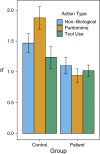Critical Motor Involvement in Prediction of Human and Non-biological Motion Trajectories
- PMID: 28205497
- PMCID: PMC5360459
- DOI: 10.1017/S1355617716001144
Critical Motor Involvement in Prediction of Human and Non-biological Motion Trajectories
Abstract
Objectives: Adaptive interaction with the environment requires the ability to predict both human and non-biological motion trajectories. Prior accounts of the neurocognitive basis for prediction of these two motion classes may generally be divided into those that posit that non-biological motion trajectories are predicted using the same motor planning and/or simulation mechanisms used for human actions, and those that posit distinct mechanisms for each. Using brain lesion patients and healthy controls, this study examined critical neural substrates and behavioral correlates of human and non-biological motion prediction.
Methods: Twenty-seven left hemisphere stroke patients and 13 neurologically intact controls performed a visual occlusion task requiring prediction of pantomimed tool use, real tool use, and non-biological motion videos. Patients were also assessed with measures of motor strength and speed, praxis, and action recognition.
Results: Prediction impairment for both human and non-biological motion was associated with limb apraxia and, weakly, with the severity of motor production deficits, but not with action recognition ability. Furthermore, impairment for human and non-biological motion prediction was equivalently associated with lesions in the left inferior parietal cortex, left dorsal frontal cortex, and the left insula.
Conclusions: These data suggest that motor planning mechanisms associated with specific loci in the sensorimotor network are critical for prediction of spatiotemporal trajectory information characteristic of both human and non-biological motions. (JINS, 2017, 23, 171-184).
Keywords: Biological motion; Domain-general; Domain-specific; Forward model; Hemiparesis; Insula; Limb apraxia; Motor planning; Parietal; Premotor; Simulation.
Conflict of interest statement
The authors declare no conflict of interest.
Figures




Similar articles
-
Neural correlates of acute apraxia: Evidence from lesion data and functional MRI in stroke patients.Cortex. 2019 Nov;120:1-21. doi: 10.1016/j.cortex.2019.05.005. Epub 2019 May 18. Cortex. 2019. PMID: 31220613
-
The impact of unilateral brain damage on anticipatory grip force scaling when lifting everyday objects.Neuropsychologia. 2014 Aug;61:222-34. doi: 10.1016/j.neuropsychologia.2014.06.026. Epub 2014 Jun 28. Neuropsychologia. 2014. PMID: 24978304
-
Bilateral functional connectivity at rest predicts apraxic symptoms after left hemisphere stroke.Neuroimage Clin. 2019;21:101526. doi: 10.1016/j.nicl.2018.08.033. Epub 2018 Aug 31. Neuroimage Clin. 2019. PMID: 30612063 Free PMC article.
-
The neural correlates of limb apraxia: An anatomical likelihood estimation meta-analysis of lesion-symptom mapping studies in brain-damaged patients.Neurosci Biobehav Rev. 2024 Jul;162:105720. doi: 10.1016/j.neubiorev.2024.105720. Epub 2024 May 15. Neurosci Biobehav Rev. 2024. PMID: 38754714 Review.
-
No double-dissociation between optic ataxia and visual agnosia: multiple sub-streams for multiple visuo-manual integrations.Neuropsychologia. 2006;44(13):2734-48. doi: 10.1016/j.neuropsychologia.2006.03.027. Epub 2006 Jun 6. Neuropsychologia. 2006. PMID: 16753188 Review.
Cited by
-
Gesture profiles distinguish primary progressive aphasia variants.bioRxiv [Preprint]. 2023 Jan 19:2023.01.19.524719. doi: 10.1101/2023.01.19.524719. bioRxiv. 2023. Update in: Aphasiology. 2024;38(11):1853-1868. doi: 10.1080/02687038.2024.2326449. PMID: 36711535 Free PMC article. Updated. Preprint.
-
Measuring the prediction of observed actions using an occlusion paradigm: Comparing autistic and non-autistic adults.Autism Res. 2022 Sep;15(9):1636-1648. doi: 10.1002/aur.2716. Epub 2022 Apr 6. Autism Res. 2022. PMID: 35385218 Free PMC article.
-
Limb apraxia and the left parietal lobe.Handb Clin Neurol. 2018;151:349-363. doi: 10.1016/B978-0-444-63622-5.00017-6. Handb Clin Neurol. 2018. PMID: 29519468 Free PMC article. Review.
-
The Limitations of Being a Copycat: Learning Golf Putting Through Auditory and Visual Guidance.Front Psychol. 2019 Feb 1;10:92. doi: 10.3389/fpsyg.2019.00092. eCollection 2019. Front Psychol. 2019. PMID: 30800082 Free PMC article.
-
A novel tablet-based motor coordination test performs on par with the Beery VMI subtest and offers superior temporal metrics: findings from children with pediatric acute-onset neuropsychiatric syndrome.Exp Brain Res. 2023 May;241(5):1421-1436. doi: 10.1007/s00221-023-06612-x. Epub 2023 Apr 13. Exp Brain Res. 2023. PMID: 37052647 Free PMC article.
References
-
- Aglioti SM, Cesari P, Romani M, Urgesi C. Action anticipation and motor resonance in elite basketball players. Nature Neuroscience. 2008;11(9):1109–1116. - PubMed
-
- Avants BB, Schoenemann PT, Gee JC. Lagrangian frame diffeomorphic image registration: Morphometric comparison of human and chimpanzee cortex. Medical Image Analysis. 2006;10:397–412. (3 SPEC. ISS.) - PubMed
-
- Bates DM, Kliegl R, Vasishth S, Baayen H. Parsimonious mixed models. arXiv Preprint arXiv: 1506.04967. 2015:1–27.
Publication types
MeSH terms
Grants and funding
LinkOut - more resources
Full Text Sources
Other Literature Sources
Medical

